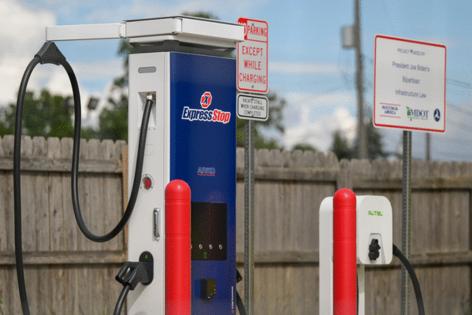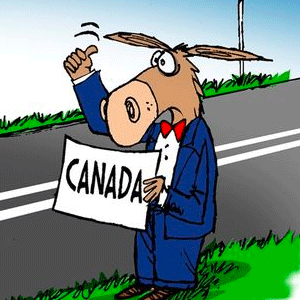Automakers brace for EV demand decline following tax credit elimination
Published in Business News
DETROIT — Automakers are bracing for a drop in electric vehicle demand after sales surged in the final days of the federal tax credit for plug-in vehicles.
The up-to-$7,500 tax credit expired on Tuesday, though companies like General Motors Co. and Ford Motor Co. said they found a workaround in an effort to extend the availability of taxpayer-funded discounts on EV leases. Nonetheless, experts suggest EV sales could halve in response to the pulled incentive, further challenging EV profits and new-energy gains, but also exposing the reality of consumer tastes.
"If the EV market drops in half in the fourth quarter, maybe more," Ford CEO Jim Farley said this week at the Ford Pro Accelerate conference, "prices will probably go up, which is also good, because right now they're artificially subsidized."
The Inflation Reduction Act signed by former President Joe Biden in 2022 as a part of economic revitalization and climate activism efforts reformed the federal tax credit to avoid disadvantaging EV innovators and encourage consumer adoptions for EVs made pricier than their gas-powered counterparts because of their batteries.
President Donald Trump, however, has blasted the incentive as part of what he calls an unfair "EV mandate." He signed the One Big Beautiful Bill Act on July 4 that cuts funding for the tax credit. The federal government also revoked California's waiver to set its own emissions standards, and his administration has proposed repealing a legal finding that is the basis for the U.S. Environmental Protection Agency's ability to regulate greenhouse gas emissions.
Ford on Wednesday reported for the third quarter an 8.2% year-over-year increase in U.S. sales to almost 546,000 vehicles, including a 30% increase in EV sales. General Motors Co.'s deliveries increased by 7.7% to more than 710,000 vehicles, and it more than doubled its EV sales. Stellantis NV recorded a 6% increase in U.S. sales; it doesn't break out its total EV sales.
Results were mixed for other major automakers. Toyota Motor Corp., Hyundai Motor Co. and Kia Corp. posted sales gains for the quarter, while Volkswagen AG, Honda Motor Co. Ltd. and Subaru Corp. reported declines.
Dealer services company Cox Automotive Inc. forecasted sales of EVs during the third quarter would be up more than 21% from the same period a year ago, at roughly 10% of U.S. sales. That would be the highest penetration for EVs yet in the United States.
Gains in EV sales, however, don't necessarily translate to higher profits. Ford's Model e EV business in the first half of 2025 lost $2.2 billion. GM Chief Financial Officer Paul Jacobson last month said the Detroit automaker's position as the No. 2 seller of EVs in the United States behind Tesla Inc. hasn't been achieved profitability. Scale, he noted, is the key to unlocking that, but that growth will be slower-than-anticipated in the coming years.
"They help get more Americans into an EV if it’s their first one but there will be a mix headwind in Q3," David Whiston, analyst at financial services firm Morningstar Inc., said in an email about EV sales gains and profitability. "That’s why lots of F-Series and Navigators are important too, as well as good pricing on off-road trims."
CFRA Research analyst Garrett Nelson in a note to investors also said Ford sold almost twice the number of hybrids than EVs during the quarter. GM doesn't have any plug-in hybrids in its U.S. lineup but plans to launch plug-in hybrids in 2027.
Ahead of the expiration of the tax credit, GM and Ford rolled out voluntary programs to their dealers that had the companies' financing arms purchase EVs in dealers’ inventory by making down payments on them. That allows them to continue to offer a discount on EV leases of existing stock.
Despite the discount scheme, Ford EV lease payments may increase depending on vehicle trim. For the Mustang Mach-E, the increase may be around $50 and for the F-150 Lightning, it's around $60 to $70. Ford spokesperson Said Deep said the company changes lease payments from month to month and quarter to quarter based on "the competitive environment."
Mike Bettenhausen, a Chicago-area Stellantis dealer who heads the company's national dealer council, said the bulk of the automaker's remaining EVs around the country were sold down prior to the deadline, thanks to a final push of incentives being offered on the vehicles. But the automaker said Wednesday it was offering discounts on remaining dealer inventory of its EVs and plug-in hybrids that essentially replicate what the tax $7,500 tax credit offered.
As opportunities for taxpayer-funded discounts dwindle, it'll become clearer who actually is looking for an EV and how many of those consumers there are. Farley suggested the market is mostly for commuter vehicles that don't need to travel far and represent about 5% to 7% of sales. Designated EV plants will have to build partially electric vehicles like hybrids or engine-extended-range EVs too, he said.
GM also is contemplating footprint adjustment as a result of the anticipated changes resulting from the tax credit cut, Jacobson said at the J.P. Morgan U.S. All Stars Conference last month: "I expect that EV demand is going to drop off pretty precipitously. We need to give it time. We need to let it settle and understand where is that natural demand going and how do we meet that natural demand and ultimately try to lead customers to electric vehicles. That's going to take a little bit of time."
Halved EV sales might be the reality for the fourth quarter, said Sam Abuelsamid, vice president of market research at auto communications agency Telemetry, especially as some sales that otherwise would have happened in the fourth quarter were pulled ahead into the third quarter. But more affordable options are set to launch soon like the Nissan Leaf, Chevrolet Bolt and Kia EV3 and EV4. All are expected to be priced in the $30,000s. Ford's $30,000 midsize electric pickup is expected to launch in 2027.
"Going into 2026, we'll probably start to see it start to pick up again," Abuelsamid said. "There's definitely demand for EVs. It's just a question of affordability."
Still, it probably won't be until 2027 when EV market share returns to 10% again, he said. Particularly hit hard from the tax credit elimination will be vehicles in the $45,000 to $65,000 range, while cheaper vehicles like the Equinox EV should fare better. The pricier EVs often weren't eligible in the first place because of the tax credit's price and household income ceilings.
Eddie Stivers, president at a dealer group that owns five Ford stores in the southern United States, said F-150 Lightning sales picked up as the tax credit expiration neared, but overall, he's not too worried about its elimination. More than half of his Mustang Mach-E sales are consumers buying the SUV over leasing, and for the past year, those transactions didn't have a tax credit anyway. Many Lightning buyers don't qualify.
"Nationally, I think there's ambient demand of 10%," he said. "I don't know that is going to change. EV buyers are EV buyers. There's a performance difference in the torque curve. There are EV buyers because of their belief in EVs being zero-emission vehicles. There are EV buyers because they have commutes and see the operational expense value for an EV. There’s more reasons than just that tax credit."
Meanwhile, Village Ford dealer Jim Seavitt in Dearborn said he sold nine Mustang Mach-Es on Monday. But given the policies being put in place by the Trump administration, he doesn't see a big year for EVs looking forward. Nonetheless, Ford is ending production of the Escape SUV at the end of the year, leaving a hole in its lineup as it retools Louisville Assembly Plant for launch of the all-electric midsize truck in 2027.
"Mach-E fills it," Seavitt said of the gap, noting not every Escape buyer wants the look or feel of a Bronco Sport, and some find the Explorer too big. "I'm getting all I can order."
Nonetheless, the Detroit Three automakers are global players, and the decline in market share for EVs will be an "isolated story" compared to the rest of the world, Farley said. Hybrids and EVs represented roughly 1.3 million U.S. sales last year. They were nearly 13 million in China.
"What isn't changing is EV sales in China and Europe," Farley said. "What's happening is Chinese now are almost 10% of the EV market in Europe. ... We could talk about the U.S., but the real EV market that matters is the demand in China, and that is not slowing down."
_____
Staff Writers Luke Ramseth and Summer Ballentine contributed.
_____
©2025 www.detroitnews.com. Visit at detroitnews.com. Distributed by Tribune Content Agency, LLC.












Comments